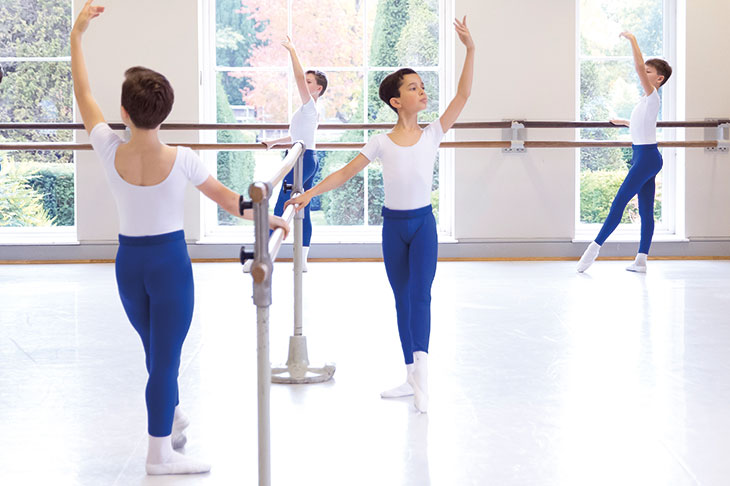‘Nose over toes.’ ‘Index fingers in.’ ‘Hands at cheekbone width.’ Watching morning classes at the Royal Ballet School in Richmond Park is a revelation. If you’ve ever sat in the stalls at Covent Garden and wondered what it takes to be Giselle, Odette or the Sugar Plum Fairy, here is your answer: devotion, dedication, concentration and several hundred pairs of worn-through slippers. And if you’ve ever wondered why the dancers of the Royal Ballet look so at home among fairytale castles, kingdoms of sweets and enchanted woods… Well, they grew up with it.
White Lodge, built as a royal hunting retreat for George II in 1730, would make an enchanting backcloth to a performance of Frederick Ashton’s Sylvia. At any moment you expect a nymph to leap from behind the science block. George II’s Consort, Caroline of Ansbach, used to canter the length of the Queen’s Ride and dismount in the loggia. Today, the loggia is the school’s health and recovery centre, with rows of pilates benches under the arches. The Royal Ballet was granted the lodge in 1955, and — alongside the School of American Ballet in New York and the Vaganova Academy in Saint Petersburg — it has become one of the top three classical ballet schools in the world. Present Royal Ballet principals Francesca Hayward, Lauren Cuthbertson and Edward Watson are all RBS alumni.

I visit during the rapturous February heatwave. Sunlight pours through the Diocletian windows of ‘the Pav’ — the Anna Pavlova studio. Eleven boys from Year 7 are at the barre. The pianist consults his iPad sheet music and the room fills with music and motion. ‘We come in all shapes and sizes,’ says White Lodge’s artistic manager, Hope Keelan, ‘and we’re all gorgeous.’ It’s true. I had expected tall boys and tiny girls. But there is no one model here. There are statuesque girls and springy boys. There are blonds, brunettes and redheads.
Pupils come from British, Indian, Chinese, Caribbean and North African families. Financial support and bursaries are given to 87 per cent of the pupils. No child should be put off auditioning for worries about fees. What the 150 pupils share is a sense of delight in the discipline of dance. Each class is quiet and purposeful. The only glum face I see is that of a boy with his leg in plaster.
Injuries do happen, but the school does everything possible to protect its pupils. The football pitch, formerly an ankle-twisting, uneven slope, has been levelled. At the beginning of each class, teachers take notes: one boy shouldn’t do jumps this week, another must leave early for a ‘strength and conditioning’ session. Nutritionists encourage pupils to eat for strength, not skinny limbs. There are 30 members of staff dedicated to health and wellbeing. Classical dancers aren’t chorus-line hoofers: they’re Olympians.
They are also the politest schoolchildren I’ve ever met. It’s certainly the first time a teenager has curtsied as she said goodbye to me. The RBS takes only 30 pupils a year — 20 years ago it was 80 per cent girls, now it’s half and half — and you sense how proud they all are to be here.
Ballet mistress Tania Fairbairn has a gift for making her Year 7 girls smile. ‘Let’s have jetés, not splats,’ she says. ‘No claw-grips on the barre, please. In real life that’ll be your partner.’
When the girls — in pink tights, lilac leotards and matching ballet-bun ribbons — look daunted by a new sequence of positions, Fairbairn urges: ‘Have courage!’ She reminds them that falling over is OK. You learn more by crumpling in a heap than by doing it perfectly first time.
White Lodge pupils take eight GCSEs, and last year the school achieved 93 per cent passes in grades 9-4 (A* to C in the old system), well above the national average of 66.9 per cent. There’s a swimming pool, an art room, a suite of music studios, a row of neat boarding houses, a costume department and a ‘tutu store’. You don’t get that at St Custard’s.

The boys and girls dance separately and take academic classes together. It is only later, preparing for the senior school at Covent Garden, that they start practising pas de deux. When the Year 7 boys cross the room in perfectly synchronised pairs it leaves the 11th boy looking momentarily lost. ‘Always take the chance to do the solo!’ says Keelan. ‘No one wants to stay in the corps de ballet.’ The last boy leaps with his head held high. Keelan tells the boys that you don’t always have to be the best, but you do have to listen to a choreographer’s corrections. ‘Sometimes the fastest learner goes furthest.’
The adjustments each dancer makes are minute, but transformative. ‘Lift the whole body up through the eyebrows,’ says Fairbairn. When the Year 9 boys start to sweat, their teacher, Zhanat Atymtayev, a former dancer with the Russian National Ballet and St Petersburg State Ballet, reminds them: ‘I like the intensity, but the sun is shining, it’s a beautiful day! It’s not brain surgery! It’s ballet — enjoy!’ After that, the boys start to relax and it’s a joy to watch them. You can’t help but play spot-the-next-Nureyev.
On the way out, I touch the finger of the bronze statue of Margot Fonteyn (a school tradition) for luck. It has been rubbed to a gleam. In a taxi through the park, I watch deer skitter. Pretty, but not a patch on the young bucks and fawns of the Royal Ballet School.







Comments